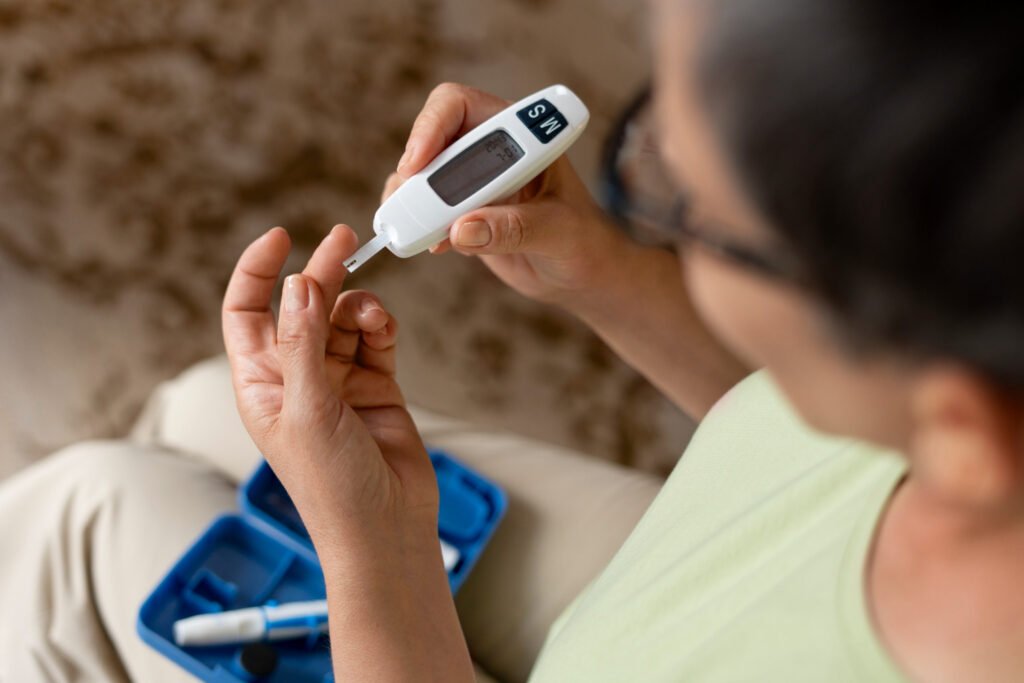
In this article
Blood sugar, or blood glucose, is the main sugar found in your blood and is crucial for energy production in the body. When you consume carbohydrates—such as bread or sweets—they break down into glucose, which then enters your bloodstream. This glucose is then used by your body for energy. Blood sugar levels fluctuate throughout the day based on various factors, including your last meal, physical activity, and medications.
Managing blood sugar levels is particularly important for individuals with diabetes, prediabetes, or insulin resistance. Keeping your blood sugar within a healthy range can prevent complications from these conditions later in life.
Understanding Blood Sugar
Blood sugar, also known as blood glucose, primarily comes from the carbohydrates you eat. Once in your bloodstream, glucose is transported to your body’s cells to be used as a quick energy source. Carbohydrates can be categorized into simple and complex carbs. Simple carbs, found in foods like table sugar and white bread, break down quickly in your body. In contrast, complex carbs, such as oats and whole grains, take longer to break down, providing a more sustained energy source.
Hormones, especially insulin and glucagon, regulate blood sugar levels. Produced by the pancreas, insulin helps lower blood sugar by allowing glucose to enter cells, while glucagon works to prevent blood sugar levels from dropping too low.
Blood Sugar Levels Explained
For most healthy individuals, the pancreas efficiently regulates blood sugar levels. However, in people with type 1 or type 2 diabetes, prediabetes, or insulin resistance, this regulation is impaired, leading to elevated blood sugar levels. Blood sugar can be measured using a simple finger prick test available for home use, at healthcare providers’ offices, or at local pharmacies.
Normal Blood Sugar Levels
Blood sugar levels vary based on the timing of your last meal. A normal fasting blood sugar level—measured after at least eight hours without food—ranges between 70-99 milligrams per deciliter (mg/dL). Postprandial blood sugar, checked two hours after eating, should be less than 140 mg/dL.
High Blood Sugar (Hyperglycemia)
Hyperglycemia occurs when fasting blood sugar is 100 mg/dL or higher or when it is 140 mg/dL or higher after a meal This condition occurs either when the pancreas fails to produce sufficient insulin or when the body’s cells develop resistance to insulin Symptoms may include fatigue, thirst, blurry vision, and frequent urination. Long-term hyperglycemia can lead to serious complications such as heart disease, blindness, and kidney disease.
Low Blood Sugar (Hypoglycemia)
Hypoglycemia occurs when blood sugar levels drop below 70 mg/dL .Symptoms might not appear until levels drop to 55 mg/dL or less. It is rare outside of diabetes but can be caused by excessive alcohol consumption, too much medication, or not eating enough. Symptoms include sweating, shaking, dizziness, irritability, and a rapid heartbeat. Immediate treatment is necessary to avoid severe complications.
Monitoring Blood Sugar Levels
There are three main ways to monitor blood sugar levels
- Blood Glucose Meter: A handheld device that provides a blood sugar reading from a finger prick within seconds. Ensure hands are clean before testing for accuracy.
- Continuous Glucose Monitor (CGM): Recommended for people with diabetes, a CGM uses a small sensor under the skin to continuously measure blood sugar levels, sending data to a device like a smartphone.
- A1C Test: Conducted by healthcare providers, this blood test reflects average blood sugar levels over the past three months, offering a comprehensive view of blood sugar management.
Maintaining Healthy Blood Sugar Levels
Achieving stable blood sugar levels is possible with a combination of a healthy diet and regular exercise. Key strategies include:
- Regular Monitoring: Continuously track your blood sugar levels to prevent sudden spikes and drops.
- Balanced Diet: Eat regular meals that balance carbohydrates with protein and fat to stabilize blood sugar.
- Exercise: Engage in physical activities, particularly aerobic exercises like walking, to help regulate blood sugar.
- Professional Support: Work with healthcare providers, including diabetes educators and dietitians, to develop a personalized and manageable plan.
Treatments for High and Low Blood Sugar
High Blood Sugar
- Exercise: Aerobic exercises can help lower blood sugar levels.
- Diet Management: Avoid eating carbohydrates alone; combine them with protein and fat to prevent spikes.
Low Blood Sugar
- Immediate Response: If experiencing symptoms of hypoglycemia, test blood sugar levels and consume a sugary snack to stabilize them.
- 15-15 Rule: For diabetes patients, consume 15 grams of carbohydrates, wait 15 minutes, and then recheck blood sugar levels.
- Long-Term Management: Collaborate with healthcare providers to implement lifestyle changes that prevent future episodes.
By understanding and managing blood sugar levels, individuals can lead healthier lives and minimize the risk of complications related to diabetes and other blood sugar-related conditions. Regular monitoring, a balanced diet, and professional guidance are essential in maintaining optimal blood sugar health
A Quick Review
Blood sugar, or glucose, is the primary sugar found in your blood, essential for energy. Maintaining healthy blood sugar levels is crucial, especially for those with diabetes, prediabetes, or insulin resistance. Regular monitoring, a balanced diet, and exercise can help manage blood sugar effectively
FAQS
What is considered a normal blood sugar level?
A normal fasting blood sugar level ranges between 70-99 mg/dL. Postprandial blood sugar, checked two hours after eating, should be less than 140 mg/dL.
How can I monitor my blood sugar levels?
You can use a blood glucose meter, a continuous glucose monitor (CGM), or have an A1C test done by your healthcare provider.
How can I maintain healthy blood sugar levels?
Regular monitoring, balanced meals combining carbohydrates with protein and fat, regular exercise, and working with healthcare professionals can help maintain healthy blood sugar levels.











